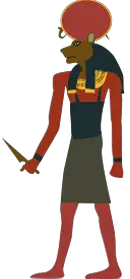The Egyptian Goddess Sekhmet
Sekhmet: Goddess of Retribution
Sekhmet was a warrior, the goddess of medicine. She was also one of the few goddesses who was given the title "Eye of Ra." A bloodthirsty punisher, she was known as a judge of humanity and was called "she who dances in blood." She is among the oldest of the Egyptian gods.
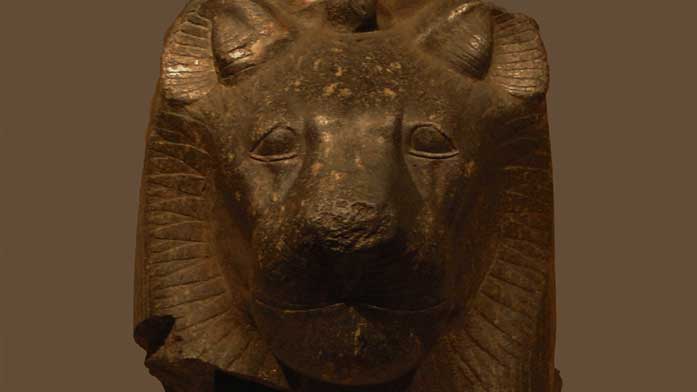
© Maia C - Statue Sekhmet
Name and Origins
There are two schools of thought concerning the meaning of her name. Some scholars believe it means "she who is powerful." Others think her name means "the one who loves Ma'at." She was a goddess sent by Ra to bring the world justice, balance, and order (ma'at).
The earliest widespread worship of Sekhmet as one of the main Egyptian deities dates back to the Middle Kingdom (between 2040 and 1782 BC). Her genesis was probably a reaction to the brutality found in lions and the hazardous nature of plagues. She was capable of sending plagues to the people of Egypt with her bow and arrow.
One of the epithets of Sekhmet is "Sekhmet of the Libyans." This indicates that she may be a goddess who was integrated into the ancient Egyptian religion. It also hints that the goddess may have first been worshipped in the Lower Kingdom, in the northern part of Egypt near the Nile Delta.
Sekhmet's Powers and Attributes
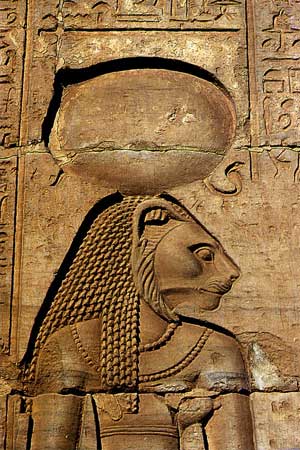
Image: © tutincommon - Relief of Sekhmet
- Protector of the pharaoh
- Cured the sick
- Defender of Egypt and his armies
- killer of the killer of the disobedient
Because of her power over plagues, Sekhmet was also considered the goddess of medicine. What she was best known for, though, was her bloodlust and vengeful nature. She was said to be able to breathe fire, which many believed was the hot desert wind. While consuming her prey or wreaking vengeance upon a people, she was known to drink blood.
Her hunting ability was augmented by her status as the Eye of Ra (a title she shared with Bastet, Hathor, and several other goddesses). The Eye could be described as an agent of Ra, in charge of locating things and communicating what it found to the sun god.
Sekhmet had seven messengers. These could be sent to find things for Sekhmet, or they could carry specific plagues to people who have disobeyed Ra. The messengers were sometimes personifications of the arrows from Sekhmet's quiver.
Because of her close connection to Ra, Sekhmet was considered the protector of the pharaoh's body and authority.
Associations with other Gods
Sekhmet was given a high level of importance in the Egyptian pantheon. She had many associates, and her relationship to each of them was often unusual. For example, she was more closely associated with her father, Ra, than her own husband.
Egyptian mythology often gave the gods two roles. In the case of Sekhmet, she was both her own discreet goddess and the alter ego or wrathful version of several other goddesses, especially the feline ones. This is vital to understand as Sekhmet's relationship with other gods is discussed.
Sekhmet and Bastet
Sekhmet and Bastet were always closely related to one another. At times, they were combined into Bastet-Sekhmet. Both were feline deities, and both were given the title "Eye of Ra." They were so close, in fact, that they were considered two sides of the same being, with Bastet being the docile, peaceful aspect and Sekhmet being the vengeful, violent side.
Sekhmet and Anubis
In some myths, Anubis was said to have married Bastet. This made Sekhmet a part of that union. There is also a natural connection. Sekhmet was a killer who brought vengeance and death down on those who disobeyed Ra. Anubis was the god of the afterlife (and later the god of embalming). He was in charge of the heart-weighing ceremony that determined whether a soul would be allowed to move into the afterlife. Sekhmet and Anubis can, therefore, be seen as two parts of the process of death and transition into the world of the dead.
Sekhmet and Hathor
Hathor was the wife of Ra. When Ra discovered human beings were disobeying and disrespecting him, he became angry. To punish those humans, Ra transformed his wife Hathor into Sekhmet and sent her into the world to exact revenge and punishment. As a result, Sekhmet was considered the wrathful alter ego of Hathor. While this is true of many of the goddesses listed here, the Hathor-Sekhmet union appears to have been the oldest since it figured into myths about the early days after the creation of the world.
Sekhmet's Husband and Son
Ptah and Sekhmet. Ptah was one of several gods who were said to have created the world. He was the patron of artisans and architects. He was also considered the husband of Sekhmet. The reasons for this have been obscured by history. Perhaps it was because both were worshiped heavily in Memphis. Perhaps it was because they represented separate aspects of divinity in general; Sekhmet was one who acted on behalf of Ra, while Ptah listened on behalf of the people who prayed to him.
They had a son named Nefertem, the god of the blue lotus and the first rays of the morning son.
Sekhmet and Ra
The most important and complex of relationships of Sekhmet was with Ra. It was Ra who sent Sekhmet to the world to exact his vengeance against the people who disobeyed him. Ra was responsible for creating Sekhmet and making her wrathful.
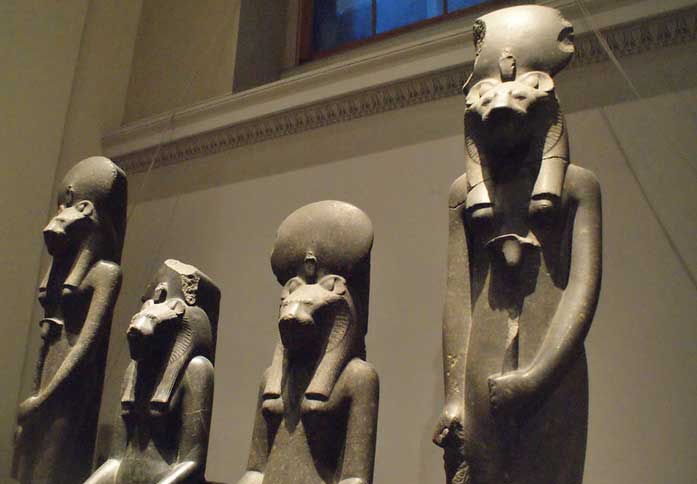
image: © Shannon - 4 statues of Sekhmet
Sekhmet's Relationship with the Pharaohs
There are among the relief carvings of ancient Egypt the image of an unknown king giving an offering to Sekhmet. Even in these instances, the king averted his eyes from the goddess, showing both obeisance and fear. While it was no secret that Sekhmet was dangerous, once appeased, she became a divine protector of both the universe and the king of Egypt.
She was not only the guardian of the physical body of the king, however. She was also his aide and protector in times of war. There are depictions of Sekhmet riding in a chariot with the pharaoh. Her rage was bestowed upon him when he entered battle. Some kings throughout Egyptian history even claimed to be the son of Sekhmet. She would turn her fiery breath upon anyone who dared approach the pharaoh with malice in his heart.
Important Myths
The most prominent myth about Sekhmet involves her role as a vengeful deity. When Ra was an earthly king and had grown old, he had lost the respect and obedience of many of his people. Therefore, Ra sent Sekhmet to kill those who had disobeyed him.
Sekhmet's vengeance was bloody and violent, and she would drink and wade in the copious blood of her victims. She was so intent on destruction that she killed the guilty and innocent alike, to the point that she threatened to destroy all people in the world.
Ra sent seven messengers (possibly also the messengers of Sekhmet) to a city called Elephantine to gather red ochre. This was then mixed with beer so that Sekhmet would mistake it for blood. She drank deeply of it and became drunk. Once inebriated, she lost interest in killing and, according to some accounts, fell asleep. She could then be pacified by the other gods.
According to some accounts, when Sekhmet awoke from her drunken stupor, the first person she saw was the god Ptah. They fell in love at first sight.
Evolution of Sekhmet
Sekhmet may have first appeared outside of Egypt and was then absorbed into the mythology of the Lower Kingdom. Unlike Bastet, however, she underwent little transformation, remaining a lioness-headed goddess through her period of worship.
It seems that, instead of evolving herself, she caused other goddesses to change. This was shown in Hathor becoming Sekhmet and the merging of Sekhmet and Bastet. She was, at certain times, considered one of the deities who created the world, but this was probably a regional myth as opposed to a general one.
Depictions
Sekhmet was depicted with the body of a woman and the head of a black lioness. On her head was the sun disk (a representation of the Eye of Ra) with an uraeus (cobra) above her forehead. She wore a tight-fitting sheath gown and was usually shown carrying a staff in one hand and an ankh in the other. Occasionally, she would be depicted fully as a lioness, especially in tombs.
While there were some funerary busts of her, she was depicted standing the vast majority of the time. Of the deities of ancient Egypt, she was one of those who has changed the least over time.
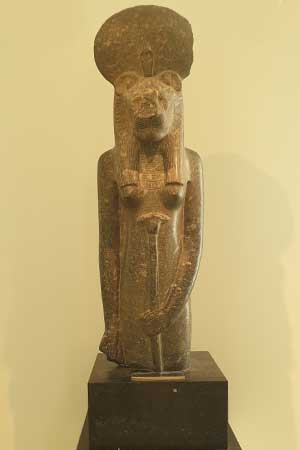
Image: © www.ancient-egypt-online.com
statue of Sekhmet
Worship and Prayers
Cats were revered and mummified in ancient Egypt. It was said that whispered prayers to such cats would be heard and answered by Sekhmet.
A prayer called "The Last Day of the Year" was recited just before the new year by priests, as it was believed Sekhmet attacked humans as the year drew to a close. Prayers were also said to her every day all over Egypt. Her main place of worship, though, was the Sekhmet temple in Memphis. This was the city where her priesthood resided.
Sekhmet was worshipped as a protector of the pharaoh, one who cured the sick, and a warrior who defended Egypt and her armies. She was also worshipped in concert with Bastet since one was often considered an aspect of the other.
Bibliography
- Egyptian Mythology.
- Sekhmet and Bastet: The Feline Powers of Egypt.London: Avalonia, 2017.
- The Gods of Egypt. Cornell University Press, 2001.
- Handbook of Egyptian MythologySanta Barbara: ABC-CLIO, 2002.

